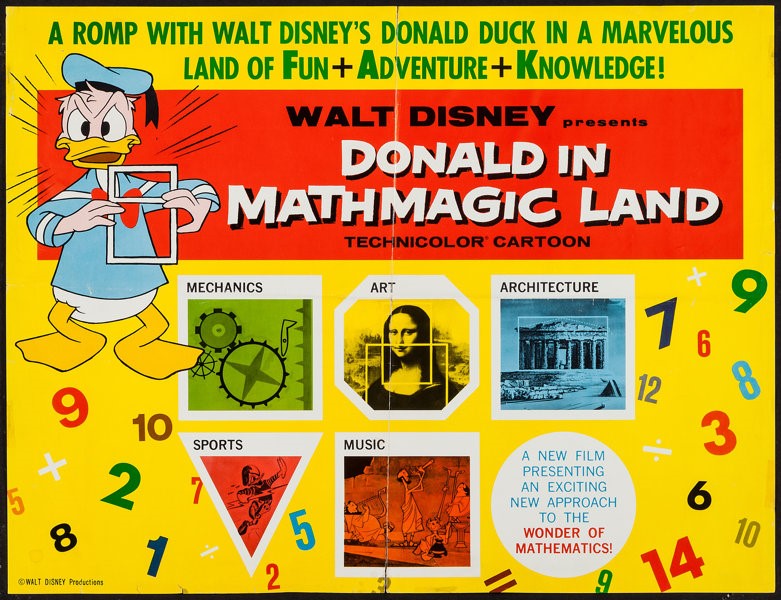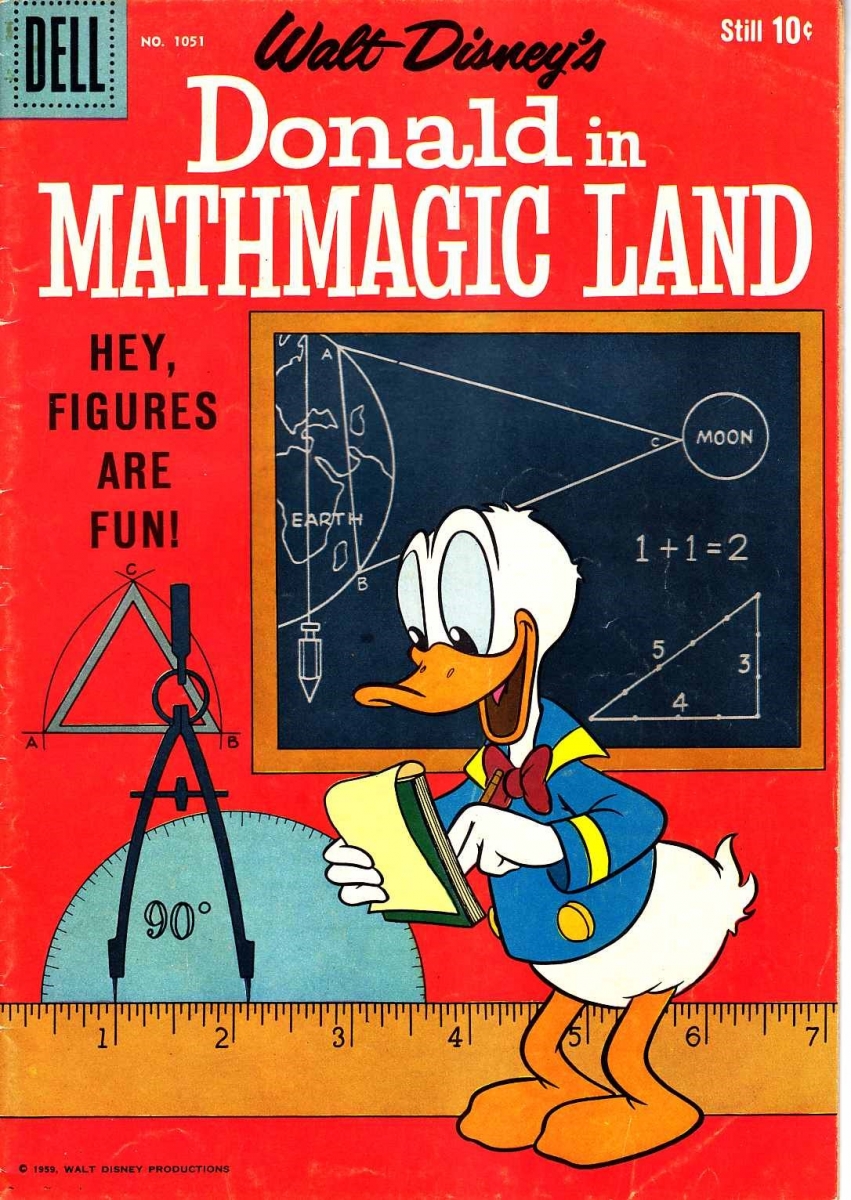- About MAA
- Membership
- MAA Publications
- Periodicals
- Blogs
- MAA Book Series
- MAA Press (an imprint of the AMS)
- MAA Notes
- MAA Reviews
- Mathematical Communication
- Information for Libraries
- Author Resources
- Advertise with MAA
- Meetings
- Competitions
- Programs
- Communities
- MAA Sections
- SIGMAA
- MAA Connect
- Students
- MAA Awards
- Awards Booklets
- Writing Awards
- Teaching Awards
- Service Awards
- Research Awards
- Lecture Awards
- Putnam Competition Individual and Team Winners
- D. E. Shaw Group AMC 8 Awards & Certificates
- Maryam Mirzakhani AMC 10 A Awards & Certificates
- Two Sigma AMC 10 B Awards & Certificates
- Jane Street AMC 12 A Awards & Certificates
- Akamai AMC 12 B Awards & Certificates
- High School Teachers
- News
You are here
Mathematical Treasure: Donald in Mathmagic Land
Donald in Mathmagic Land is a 27-minute educational cartoon that was produced by the Walt Disney Educational Media Company during the height of the US reaction to Sputnik. It premiered on June 26, 1959 (see the theatrical release poster), on a bill with the full-length Disney film Darby O’Gill and the Little People. Two years later, Donald in Mathmagic Land became the first televised Disney cartoon to appear in color on the premier episode of the NBC-TV show Walt Disney’s Wonderful World of Color, broadcast on September 24, 1961. (Prior to this time, Disney cartoons aired in black-and-white by ABC-TV under the title The Magical World of Disney.) An immediate success with audiences, Donald in Mathmagic Land was nominated for (but did not win) an Academy Award (in 1959, for Best Documentary-Short Subject) and was recognized for outstanding achievement by the 13th Edinburgh International Film Festival (1959), the Southern California Motion Picture Council (1959), the Mexico Instituto De Cultura Cinematográfica (1962) and the International Educational Film Festival of Ministry of Education (1976).

Original theatrical release poster, from the collection of Dr. Sid Kolpas.
In the film Donald in Mathmagic Land, the cartoon figure Donald Duck (voiced by actor Clarence Nash) is guided through Mathmagic Land by the unseen “True Spirit of Adventure” (voiced by actor Paul Frees). As a result of his Alice-in-Wonderland-like adventure, Donald learns about the uses of mathematics in music, games, logic, art, dance, and science, and he comes to discover the beauty of mathematics. The mathematical concepts featured in the film focus on ratios, proportion, angles and basic geometrical shapes. German physicist and science writer Dr. Heinz Haber served as a technical advisor on the mathematical and scientific content of the film. The non-speaking live billiards player featured in the angle geometry segment of the cartoon (16:49–22:15) was played by the 3-cushion billiards tournament player Roman Yanez. The cartoon was directed by Hamilton Luske. It concludes with a quote by Galileo: “Mathematics is the language with which God has written the universe.”

Animation Cel, from the collection of Dr. Sid Kolpas.

Animation Cel, owned by the author’s daughter.
In a 1959 magazine interview, Walt Disney commented on the value of animation for educational purposes:
The cartoon is a good medium to stimulate interest. It is an ideal medium for teaching and it has always been my hope that we could do something that way. But it would have to be of general interest, yet helpful in teaching. It should be used for opening people’s minds and meeting their needs. We have recently explained mathematics in a film and in that way excited public interest in this very important subject. Donald in Mathmagic Land stimulated interest in mathematics and turned out very well. [Disney, 1959]
In keeping with this vision, the cartoon Donald in Mathmagic Land was made available from Disney to schools on film (and later available to the public on videotape and DVD). Dell Comics also published a comic book of the cartoon, which contained additional content (see cover below). In the 1980s and 1990s, Dale Seymour Publications sold a reprint of the comic along with the cartoon—initially on videotape and then on DVD—with permission to duplicate the comic for classroom use.

Donald in Mathmagic Land comic book, from the collection of Dr. Sid Kolpas.
Classroom Use
Every year in my 48-year teaching career I incorporated Donald in Mathmagic Land in many of my classes. Throughout my twenty years teaching secondary mathematics (1970–1990). I showed the film the day before winter break (that’s not the time to teach anything new), and assigned students to write a two-page essay on what they learned from the film, worth 25 points. During my 28 years teaching college, the film fit wonderfully with many topics in my Liberal Arts math classes, and I was legally able to distribute the comic book to all students in PDF format. Students were asked to view the film on YouTube, read the comic book, and relate both to what they learned in class, worth 25 points.
Other instructors (especially at the middle school and high school levels) choose to use Donald in Mathmagic Land in the classroom in more structured ways, by providing students with worksheets as a means to focus and guide their attention while viewing the film. A standard design approach found in many of the sample worksheets available online employs three separate categories of student questions. These categories and some sample questions from each are:
- “Preview Questions” intended to promote general reflection on mathematics and set the stage for viewing the film, such as
- What is your first thought when you hear the word “math”?
- Name one thing that has surprised you about math.
- Do you ever use math to solve everyday problems? If so, how?
- Can you name some ways that math is present in nature? In architecture or art? In sports or games?
As an alternative to individual written answers to preview questions, some instructors have students instead discuss them in small groups, either before viewing the film in its entirety or before viewing certain segments of it.
- “Viewing Questions” consisting of short answer or fill-in-the-blank questions that are intended to ensure student attentiveness while viewing, such as:
- List five places mentioned in the movie where you can find the golden ratio. Your answers can be in architecture, art, or nature.
- Lewis Carroll wrote the book ___________________, in which Alice is a pawn on a chessboard.
- Name three different games or sports mentioned in the movie that are played on geometrical areas.
- Why would some of the doors at the end of the movie not open? What was the key to opening those doors?
- “Post-viewing Questions” intended to promote further reflection or exploration of ideas raised in the film, such as:
- Pythagoras wrote, “Everything is arranged according to number and mathematical shape.” What do you think he meant by this? Do you agree with him? Why or why not?
- What are some ways that math is a part of your daily life? What about the lives of the people in your community? The government?
- The movie refers to a number of games that rely on geometric or other math principles in order to be played. What were some of these games and how is math used in them? What other games do you know of that use math principles in some way?
- The video spans three millennia and shows mathematical achievements from ancient to modern times. What are some inventions that exist today that weren’t shown in the video? Name some ways that math is used in these achievements.
Post-viewing questions might also include prompts that focus on specific mathematical topics that Donald meets in Mathmagic Land, such as:
- List 10 geometry terms or shapes that were mentioned in the movie.
- What three-dimensional shape do you get if you spin a circle? What if you spin a triangle?
Some instructors use Donald’s adventure more simply as a launching point for studying specific mathematical content that is mentioned in the film, such as the golden ratio or the golden rectangle.
Generic resources that are adaptable to this and other educational films, including a set of Film Discussion Questions and a Film Study Worksheet, are also available from the website Teach with Movies, which also provides an overview page specific to Donald Duck in Mathmagic Land.
Instructors who work with pre-service mathematics teachers could also use Donald Duck in Mathmagic Land as part of a lesson-planning assignment in which prospective teachers are asked to develop learning activities that incorporate cartoon or film medium. Teacher educators interested in promoting an understanding of how to develop cross-curricular projects in particular may find the workshop described in the paper “A Cross-curricular Teaching Project based on Walt Disney’s Cartoon Donald in Mathmagic Land” [Sajka et al., 2007] to be useful.
References
Disney, Walt. “From the Wisdom of Walt Disney.” Wisdom: The Magazine of Knowledge for Lifetime Learning and Education, December 1959.
Sajka, Mirosława, Konstantinos Tatsis, & Edwin Watson. “A Cross-curricular Teaching Project based on Walt Disney’s Cartoon Donald in Mathmagicland [sic].” Paper presented at The International Commission for the Study and Improvement of Mathematics Teaching (CIEAEM) Conference, Dobogókő, Poland, 2007.
Sidney J. Kolpas (Delaware County Community College), "Mathematical Treasure: Donald in Mathmagic Land," Convergence (May 2020)




